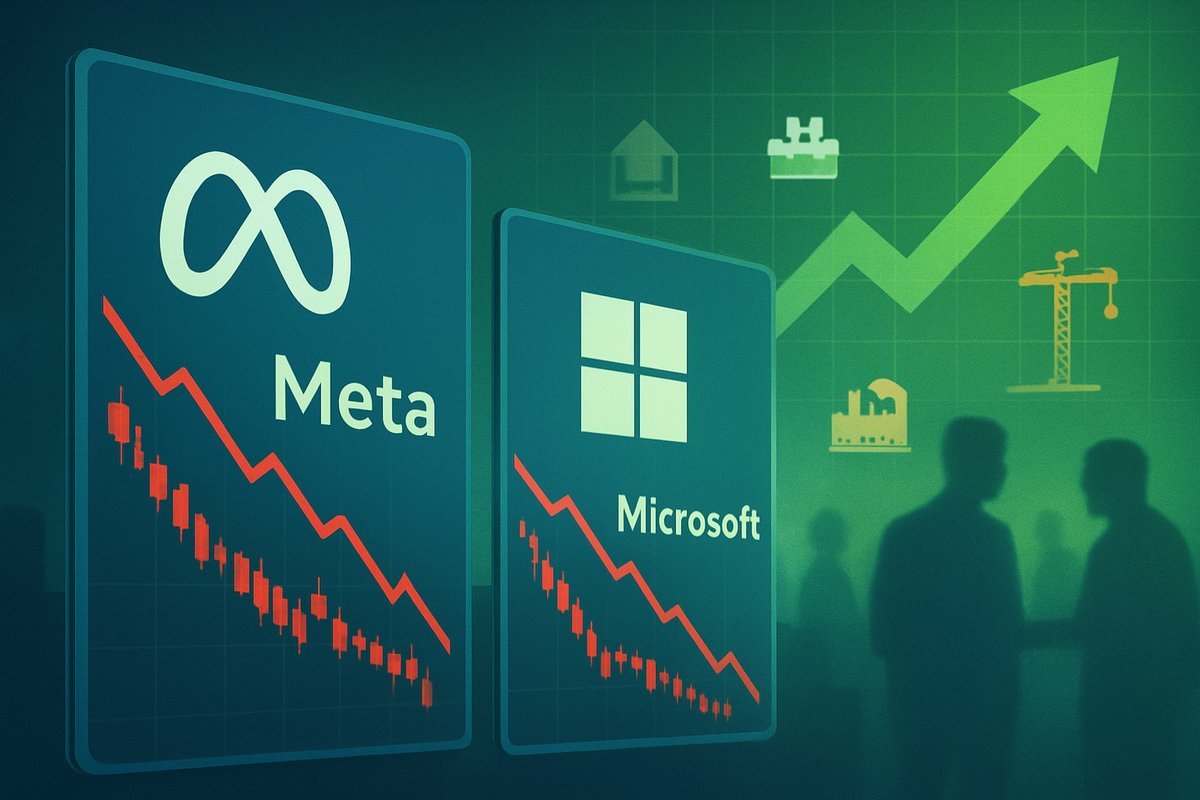
October 30, 2025 – In a significant market shift observed today, the S&P 500 index found itself under considerable pressure, primarily weighed down by the disappointing performances of technology giants Meta Platforms (NASDAQ: META) and Microsoft (NASDAQ: MSFT). This downturn in the tech sector, however, was counterbalanced by a robust rally in the Dow Jones Industrial Average, signaling a clear rotation of investor capital out of high-growth tech stocks and into more defensive and value-oriented sectors. The divergence highlights a growing sentiment among investors to de-risk portfolios and seek stability amidst evolving market dynamics.
The immediate implications of this rotation are a re-evaluation of the premium valuations placed on some of the largest technology companies and a renewed focus on fundamental strength and consistent profitability. While the tech-heavy Nasdaq Composite also experienced declines, the Dow's resilience suggests a broader market appetite for sectors less exposed to the volatile growth narratives that have dominated recent years.
Deep Dive into the Tech Sector's Turbulence and Market Rebalancing
Today's market movements were a direct consequence of investor reactions to the latest earnings reports and future outlooks from Meta Platforms and Microsoft. Meta Platforms (NASDAQ: META) saw its shares plummet by approximately 12% following its third-quarter results, which fell short of high investor expectations, particularly concerning advertising revenue. Adding to the concern were the company's substantial and ongoing investments in the metaverse, which continue to be a significant drag on profitability. A nearly $16 billion one-time tax-related charge further impacted its Q3 profits, and projections for "notably larger" capital expenditures in 2026 fueled investor anxieties over future costs and returns.
Microsoft (NASDAQ: MSFT) also contributed to the S&P 500's woes, with its stock declining by 1% to 3%. The tech behemoth faced scrutiny over challenges in its cloud computing growth, a sector previously seen as an unshakeable growth engine. Investors also expressed increased concern over the company's record-high AI infrastructure spending in the September quarter. Furthermore, a $3.1 billion investment in OpenAI reduced Microsoft's quarterly earnings, adding to the negative sentiment and raising questions about the immediate return on its aggressive AI strategy.
In stark contrast, the Dow Jones Industrial Average demonstrated remarkable resilience, gaining approximately 0.8% on the day. This divergence underscores a strategic investor rotation away from what are increasingly perceived as overvalued tech stocks. Capital flowed into sectors offering more stability and value, as market participants sought refuge from the tech downturn. This shift suggests a more cautious approach, prioritizing strong balance sheets and consistent earnings growth over speculative future growth prospects.
The Shifting Sands: Identifying Winners and Losers in the Market Rotation
The current market environment is creating a clear divide between companies that are struggling to meet lofty expectations and those that are benefiting from a flight to quality. On the losing side, Meta Platforms (NASDAQ: META) and Microsoft (NASDAQ: MSFT) are the most prominent examples, with their recent earnings reports highlighting the challenges of maintaining hyper-growth and profitability simultaneously. Their significant capital expenditures on futuristic endeavors like the metaverse and AI infrastructure are being met with skepticism regarding immediate returns, leading to substantial share price corrections. Other tech companies, particularly those with high valuations and less diversified revenue streams, may also face increased scrutiny as investors reassess their risk appetite.
Conversely, several sectors and individual companies emerged as clear beneficiaries of this investor rotation. Defensive sectors, known for their consistent performance regardless of economic cycles, saw significant inflows. Healthcare and Big Pharma, in particular, witnessed a surge in interest, as investors sought the stability offered by established pharmaceutical and medical stocks. Even biotech, a typically riskier niche within healthcare, showed strong performance, indicating a broader positive sentiment towards the sector.
Retailers and essential goods providers, such as Target (NYSE: TGT), also gained ground, reflecting a preference for companies with stable consumer demand. Beyond traditional defensive plays, the Energy Storage and Photovoltaic sectors attracted capital, viewed as healthy areas for growth within a more diversified portfolio. Notably, large-cap companies with robust balance sheets and consistent earnings growth across various sectors, particularly those with global reach and diversified revenue streams, were favored. An excellent example is Caterpillar (NYSE: CAT), which reported strong third-quarter profits exceeding expectations, leading to an impressive 11.6% jump in its shares, signaling investor confidence in its fundamental strength.
Broader Implications: A Reassessment of Market Fundamentals
This significant market event, characterized by the S&P 500's tech-led slump and the Dow's value-driven ascent, signifies a crucial inflection point in broader industry trends. For years, the market has been captivated by the "Magnificent Seven" tech giants, often overlooking traditional valuation metrics in favor of growth narratives. Today's rotation suggests a profound re-evaluation of these growth-at-any-cost strategies, with investors increasingly demanding clear pathways to profitability and sustainable returns on massive investments in areas like AI and the metaverse. It fits into a broader trend of market participants becoming more discerning, moving away from speculative growth and towards tangible value.
The ripple effects of this shift are likely to extend beyond Meta and Microsoft. Other technology companies, particularly those with high valuations predicated on future potential rather than current profitability, could face similar pressures. Partners and suppliers within the tech ecosystem might also experience adjustments in demand or investment as tech giants recalibrate their spending. While no explicit regulatory or policy implications have emerged directly from this event, a sustained period of high spending on AI and potential market concentration in these advanced technologies could eventually draw the attention of antitrust regulators.
Historically, such rotations from growth to value are not uncommon. Periods of intense technological innovation and subsequent market corrections have often seen investors pull back from speculative assets in favor of more established, dividend-paying, or fundamentally sound companies. Comparisons can be drawn to the dot-com bubble burst of the early 2000s, where an overreliance on future potential without corresponding profits led to a significant market correction and a subsequent shift towards more conservative investments. While the current situation is distinct, the underlying principle of re-evaluating overextended valuations remains a powerful historical precedent.
Navigating the Path Forward: What Comes Next
Looking ahead, the market is likely to experience continued volatility, particularly within the technology sector, in the short term. Investors will be closely watching the next round of earnings reports from other major tech players to gauge whether this rotation is an isolated event or the beginning of a more sustained trend. Companies that have heavily invested in speculative growth areas, such as Meta's metaverse or Microsoft's aggressive AI spending, will face increased pressure to demonstrate clear returns on these investments. Short-term possibilities include further corrections in overvalued tech stocks and continued strength in defensive and value sectors.
In the long term, this event could catalyze a significant strategic pivot for many technology companies. The era of unchecked growth at any cost may be waning, giving way to a renewed emphasis on efficiency, profitability, and sustainable business models. Companies might need to adapt their strategies, prioritizing proven revenue streams and more disciplined capital allocation over ambitious, long-term speculative projects. This could lead to a healthier, more balanced market environment where fundamental strength is rewarded more consistently.
Market opportunities are likely to emerge in sectors that have been overlooked during the tech boom, offering attractive valuations for long-term investors. Challenges will include navigating a potentially slower growth environment for some tech segments and adjusting to a market that is less forgiving of missteps. Potential scenarios range from a gradual rebalancing of portfolios to a more pronounced shift that reshapes market leadership. Investors should prepare for a period where diversification and a focus on intrinsic value become paramount.
A Comprehensive Wrap-Up: Key Takeaways and Future Watchpoints
Today's market action serves as a crucial reminder that even the most dominant companies are not immune to investor scrutiny and shifting market sentiment. The S&P 500's decline, driven by Meta Platforms (NASDAQ: META) and Microsoft (NASDAQ: MSFT), while the Dow Jones Industrial Average gained, underscores a significant rotation out of high-growth technology and into more stable, value-oriented sectors. Key takeaways include the increasing demand for tangible returns on large-scale investments, a re-evaluation of tech valuations, and a renewed appreciation for companies with strong fundamentals and consistent profitability.
Moving forward, the market is likely to be characterized by a more discerning investor base. The "Magnificent Seven" narrative, which has propelled tech stocks to unprecedented heights, may begin to unravel as investors seek diversification and stability. This could lead to a more balanced market where different sectors contribute more evenly to overall growth. The lasting impact could be a recalibration of market expectations, fostering an environment where sustainable growth and profitability are prioritized over speculative ventures.
Investors should closely watch several factors in the coming months. Future earnings reports from tech companies will provide critical insights into whether this is a temporary blip or a more fundamental shift. Economic data, interest rate policies, and geopolitical developments will also play significant roles in shaping market sentiment. A keen eye on capital allocation strategies within tech giants, particularly regarding AI and metaverse investments, will be essential. Ultimately, a diversified portfolio with a focus on companies demonstrating strong fundamentals and clear value propositions appears to be the prudent strategy in this evolving market landscape.
This content is intended for informational purposes only and is not financial advice





